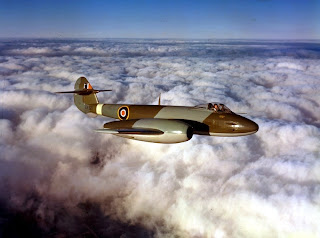Neill Michael Daunt OBE 1909-1991

 The first Meteor to actually fly took to the air on 5 March 1943, with Michael Daunt at the controls. It was the fifth in the prototype manufacturing sequence and was fitted with de Havilland Halford H.1 turbojets, the ancestor of the Goblin.The prototype F.9/40, DG202/G, powered by Rolls-Royce 1,700 lb W2B/23 engines, was flown by Michael Daunt, from Barford St. John airfield on July 24, 1943. The Meteor was also the first jet to be fitted with intake guards, invented by Gloster test pilot Michael Daunt after he was sucked head first into a Meteor during ground running tests.
The first Meteor to actually fly took to the air on 5 March 1943, with Michael Daunt at the controls. It was the fifth in the prototype manufacturing sequence and was fitted with de Havilland Halford H.1 turbojets, the ancestor of the Goblin.The prototype F.9/40, DG202/G, powered by Rolls-Royce 1,700 lb W2B/23 engines, was flown by Michael Daunt, from Barford St. John airfield on July 24, 1943. The Meteor was also the first jet to be fitted with intake guards, invented by Gloster test pilot Michael Daunt after he was sucked head first into a Meteor during ground running tests.


Michael Daunt was one of the test pilots for Britain’s pioneer gas turbine aircraft the Gloster Whittle E28/39, which in 1941 became the first aircraft in Britain and the USA to fly under jet-propulsion. He later became the Chief test pilot for the Gloster Meteor twin-jet fighter which entered service in 1943.
He was probably the first ever person to be sucked into a jet engine, luckily for him there was no front end compressor blades that you can see on modern jet engines. Equally lucky, his wide shoulders prevented him from entering the nacelle. Using the word lucky again, he kept his mouth shut otherwise his lungs would have instantly emptied of oxygen. After this accident the Meteor was fitted with a grill called the “Daunt defender”.
He was an undergraduate of St. Catherine’s College, Cambridge. He was accepted for the university’s air squadron at Duxford, were he learned to fly. He failed to reach the required academic standard (he was reading engineering) and was dropped.
In 1930 he joined the Royal Air Force on a short service commission and served with 25 Squadron at Hawkinge, Kent. The unit was equiped with Hawker Fury bi-planes , and were a 9 strong aerobatic team (which were later to become the Red Arrows). He was a wing three-quarter and represented the RAF at rugby (v the Army in 1931), and played for London Irish during the 1933-34 season.
In 1935 he left the RAF and joined the De Havilland Aircraft Company at Hatfield as a flying instructor. The following year he became a test pilot for Hawker were he met the Managing Directors daughter who he later married. In 1937 he became the deputy test pilot for Gloster. He took charge of the test programme after the chief test pilot Jerry Sayer died in a flying accident. In 1942 he demonstrated the E28/39 to Winston Churchill. During 1943 while flying an experimental Folland jet, the aircraft lost its tail during a dive. He was thrown through the cockpit roof. He was saved by his parachute, but had no recollection of pulling the ripcord. His was almost strangled by his harness as well as broking a collar bone and a wrist. He retired from test flying in 1944 after miraculously landing a Meteor that had suffered a comprehensive compressor failure in mid-air.
He was awarded an OBE in 1945 Birthday Honours for services to test flying.
After the war he had a spell farming, became a sales engineer, and for 10 years was chief technician of the kidney unit at Birmingham’s Wordsley Hospital.


<< Home